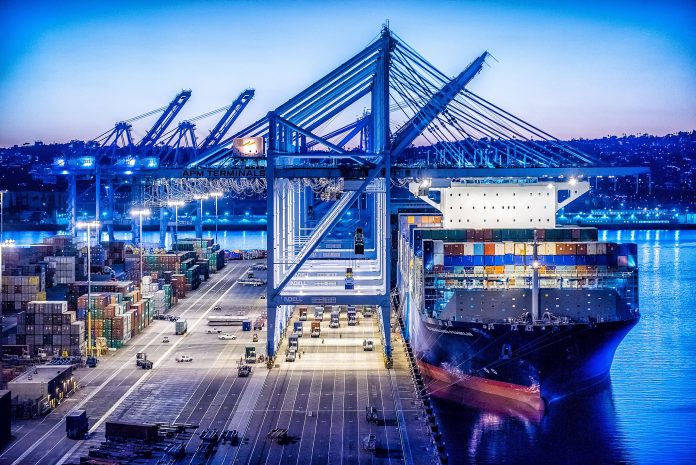Shipping goods remains a physical act, but the administration around trade is being transformed by the digital revolution that is sweeping across the globe and that has been accelerated by the pandemic.
Digitalisation has certainly brought new products and features to the shipping market with lines taking advantage of technological developments to provide upgraded and innovative services to their customers, such as the guaranteed options for delivery at a higher price, and to improve their internet applications that will ease the online interaction with customers.
Hapag-Lloyd chief digital officer, Dr. Belusa told Container News that “it is a continuous process of innovation and every company needs to fulfil new demands from customers and provide new products,” differentiating the new products into three types.
First, he mentioned there are improvements on the core products like Hapag-Lloyd QuickQuotes, to automate the quotation process and make this core-system process as fast as possible for the carrier’s customers.
In addition, there are incremental additional product improvements, like additional services with products like buying additional free time or a shipping guarantee and cargo insurance. And finally, there are disruptive services such as blockchain or other types of digital connections.
“That is an easy framework to structure innovations and focus on all three types of innovation and reinvention of the company,” he noted.
ZIM, which remains an independent line, not in any alliance, has sought to differentiate its business by developing its digital services. Two years ago, the Israel-based company introduced its technology-oriented vision “Innovative Shipping Dedicated to You”, which has been reflected by millions of dollars in investments in its Information Technology (IT) systems, digital tools, and other initiatives.
The carrier has seen significant progress in its eCommerce capabilities, introducing eZIM, a fast and easy way to place customer booking & shipping instructions, as well as its complimentary service eZQuote, introducing an instant quoting and booking platform, offering fixed price with equipment and loading guaranteed.
“On top of those we have enlarged the number of other external eCommerce platforms which we are directly integrated with, so that each customer to choose his own preferred channel that meets their needs,” said ZIM.
Furthermore, the container line has indicated several digitalisation advantages in its online applications. ZIM told Container News that during its digital campaign it has significantly upgraded the company’s official website functionality, including live chat support, as well as introducing an advanced complimentary Personal Area called ‘myZIM’, which has a wide range of services customised down to the level of the individual user within each business customer, such as personal notifications feature.
ZIM sees technology as the tool to develop all its main key layers. Apart from the above-mentioned digital customer-facing platforms, the company has used digital innovations to also introduce an internal support system for Sales & Customer Service teams. “For example, during the last two years we have equipped our customer service representatives with the most advanced contact centre systems directly connected to our customer relationship management (CRM) system enabling them to truly ‘know’ their customer, alongside a leading knowledge management system, all fully available ‘remotely’ to support a full working from home environment,” explained ZIM.
Moreover, we have seen that technology developments can enhance shipping lines’ services giving them the possibility for cargo prioritisation. A representative case constitutes CMA CGM’s introduction in August 2020 of “SEAPRIORITY get” and “SEAPRIORITY reach”, two new solutions that offer priority equipment, boarding, discharge and expedited delivery to inland destinations.

Shachar Tal, the shipping technology company Loginno’s founder and CEO, sees the digitalisation of the industry as the chance for the carriers to focus on port-to-port operations and door-to-door delivery solutions. He clarifies that it does not mean that the shipping companies should replace the freight forwarders’ role, “it is just a view that they would have to adopt in order to stay relevant to the customer,” he told Container News.
Tal added that freight forwarders gained a number of customers when they started taking cargo door-to-door but many carriers still did not learn. “I believe that the hit to the shipping companies, which would still refuse to learn that fact, will be harder in the age of digitalisation,” he emphasised.
Another main digital development in shipping carriers’ operations is the transition from the traditional paper bill of landing (B/L) to an electronic one. ZIM believes that one of the most popular features among myZIM users is its latest Draft B/L, which has digitised the traditional process of approving or editing the draft bill of lading, where the two parties involved in its creation can now collaborate digitally, very similar to managing a joint Word document.
Additionally, the Israeli container line is developing collaborations with several startups, such as WAVE and Ladingo, to move into the digital B/L based on secured blockchain platforms.
Digital trust technologies, like blockchain, are designed to improve the speed and ease with which non-financial performance metrics like carbon emissions can be tracked, aggregated, and reported, said the multinational professional services network, KPMG in its “Digitization and Decarbonization in the new reality” report.
The two hot topics of the shipping industry are digitalisation and decarbonisation, which are two closely related fields with the success of the second significantly impacted by the developments and innovations from the first.
Energy companies must be willing to invest in and bank on developing technologies such as the IoT and 5G, as well as blockchain, machine learning and Artificial Intelligence (AI), said Mathias Steck, executive VP and Asia regional manager in the Digital Hub sector of DNV GL – Digital Solutions.
That shows that shipping decarbonisation cannot be a reality without the use of modern, innovative, high-tech digital tools and systems, which will assist shipping companies to reduce their emissions.

“It’s not only about decarbonisation, using different fuel types and coating the ships,” noted Dr. Belusa, “it’s how we work together and using IT infrastructures and digitalisation.”
“Having server farms, which are CO2 friendly is one part,” he said, “but also on the other side understanding the sustainability development goals (SDG), like lifelong learning, and how we connect this to have a broader picture about climate goals is equally important.”
The Just-in-Time (JIT) Port Call initiative of the Digital Container Shipping Association (DCSA) is an indicative case, which shows how technology and digital processes can lead shipping lines to reduce their carbon emissions.
Thomas Bagge, CEO of the association explained, “By moving container shipping towards a JIT port call process, DCSA digital standards will enable container ships to optimise their steaming speed, thereby lowering fuel consumption and reducing CO2 emissions. The standards will allow carriers, ports and terminals to exchange event data in a uniform way, enabling digital planning and operational optimisation.”
Widespread adoption is the first step towards achieving a digital, global, transparent, just-in-time port call ecosystem, according to Bagge, who pointed out that especially “for ports, the ability to provide more innovative, efficient and sustainable operations are a strategic advantage.”
Regarding the new challenges that shipping companies have to face through the digitalisation process, Dr. Belusa highlighted the kind of end-to-end customer responsibility, as customers expect more, for example, a bigger variety of options or more flexibility. Therefore, the carriers need to follow their customers’ demands and deliver a more flexible and comprehensive product.
Tal claimed that smart containers can enhance the quality of the products that shipping companies offer, while at the same time they can increase their efficiency and decrease their carbon footprint. Smart boxes provide better utilisation, as the lines can serve the same number of customers with fewer containers. That leads to the need for a smaller fleet of containers for each company, which increases operational efficiency and in the long term reduces carbon emissions.
While some shipping experts believe that we are already in the digital era of shipping and others consider that we have not jumped onto the digital bus yet, the fact that technology has already caused major changes in the shipping companies’ processes and operations is not debatable.
Container News understands that shipping lines will sooner or later be compelled to resile from several traditional methods and tools and move into new automated processes and systems. That radical change has expectedly alarmed the conservative shipping industry, but year by year all the participants of the shipping supply chain are becoming increasingly familiar with the digital vision.
The crucial point of shipping and supply chain digitalisation is the link between the technology process and the physical movement of goods and the key mechanism to achieve that is to build, measure, learn and manage this combination, according to Hapag-Lloyd chief digital officer, Dr. Ralf Belusa.
Shipping lines are the part of the chain, which must find a way to connect online and offline applications and digital developments with the physical nature of cargo transportation.
“The companies which will manage this combination between online and offline, between physical movement of goods and digitalisation in an intelligent way, will win,” pointed out Dr. Belusa.
Technology innovations are steadily transporting the industry into the digital age, but that does not mean that we can create a fully digital manifestation of logistics, according to Shachar Tal, who agreed that there is a need for a combination of the digital and physical powers in shipping.
He believes that the physical aspect of logistics will remain and will continue to play a main role in the supply chain processes, but at the same time, he highlighted the ability of Internet of Things (IoT) to transform the physical into the digital realm.
This digital transformation has already provided important developments in data sharing between shipping lines, ports and other stakeholders in the shipping industry. Dr. Belusa believes that the common standards in the industry, like the DCSA data standards for exchanging data, will allow shipping lines, ports and other stakeholders to connect.

The purpose of DCSA is to establish IT standards that will enable interoperability of technology solutions across the industry, according to Thomas Bagge, who believes that “this will provide a foundation for industry-wide digitalisation along the lines of what is happening in banking, telco and the airlines.”
Bagge told Container News, “Currently, container shipping lacks a common approach to technology and therefore information exchange between parties is difficult and this leads to inefficiency, waste, and high costs.”
The DCSA CEO argued that digitalisation standards will unify the way industry participants interact with each other. “By creating a common data language and framework for processes based on shared opensource requirements, DCSA’s standards will enable stakeholders to send and receive data in a way that is understandable and usable for all participants regardless of their choice of technology platforms,” he added.
Meanwhile, Shachar Tal focussed on data sharing implementation in the smart containers’ field, where it is used mainly for visibility purposes, while it is provided by the shipping company which owns and operates the boxes to the rest of the chain, which includes ports and trucking companies among others.
Ports, in particular, could significantly improve their performance through smart containers, according to Tal, as they [ports] will get real-time feedback on containers that are supposed to come on a certain day.
Additionally, the existence of smart containers can have a dramatic effect both on the level of service that the shipping company can give to its customers and the internal operations of the company. Tal emphasised that smart containers offer much higher visibility and fewer mistakes. Smart boxes do not usually have a direct effect on measurable figures, so although they are not expected to offer shorter transit times or increased vessel speed, they assist in the overall optimisation of several operational processes, which leads to fewer mistakes, equipment remains more available and overall service is much more reliable and transparent, according to Shachar Tal, who concluded that smart boxes cause “an effect on the quality of service more than the actual physical speed of it.”
The increased transparency from digitalisation was also highlighted by Dr. Belusa, who gave the example of a common sailing route to outline the customer advantages gained from technological developments.
“In a routing from Singapore to Rotterdam, the customers have several data points and information like shipment date, transition times, bill of landing (B/L) documentation, etc. and the digitalisation helps to make this routing with all additional important data more transparent, faster and ease of doing business,” he said and concluded, “With digitalisation shipping lines can deliver a better quality of services, increased transparency, and in the end, an overall better service for the customers.”
However, Shachar Tal believes that we are still at the beginning of shipping digitalisation, pointing out that we have not even scratched the surface of business process automation. The following example of Loginno’s founder is very interesting and indicative of what we should expect in the future from the digitalisation of the industry.
“As a shippers’ cargo which was supposed to be on schedule is being tracked in real time, compared to the forecast it is very late and will not make the deadline. That shipment is so crucial to the shipper that a replacement shipment by air is necessary. An automated rule is then being executed which scans the contents of the specific container, detects the sensitive items, creates an air bill to ship them by air and sends it all to the operation manager’s email for approval.”
Tal noted that “unfortunately we’re still a few steps behind. We have to take care of the infrastructure before all of these wonderful automations can happen.”
Conversely, Dr. Belusa claims that the vast majority of shipping companies are already fully fledged members of the new technology era, but it just takes longer to implement and connect all the involved parts due to the complexity of the supply chain and logistics.
However, he said, “If you look at the technology and IT systems in the shipping industry, sales, customer service is using AI for optimising emails and shipping documents, ongoing blockchain projects, all that shows that the future is now.”
The Israeli carrier ZIM believes that the container shipping industry is relatively conservative compared to other “early adopter” sectors and said that the main challenge is always in the actual implementation, encouraging customers to embrace the change by choice and not by default.
In any case, the digitalisation of the shipping industry is inevitable, according to Shachar Tal, who mentioned time as the only parameter, that could not derail but delay the digitalisation of the industry. Bad product market fit from the providers or inability to drive value from digitalisation are some cases that could retard the pace of the digitalisation process, but “sooner or later all these will be solved.”








